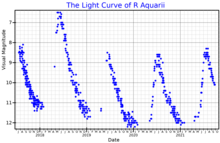
Delta Aquarii, officially named Skat, is the third-brightest star in the constellation of Aquarius. The apparent visual magnitude is 3.3, which can be seen with the naked eye. The distance to this star is about 113 light-years based upon parallax measurements, and it has a close companion.

Mu Aquarii, Latinized from μ Aquarii, is the Bayer designation for a binary star system in the equatorial constellation of Aquarius. It is visible to the naked eye with a combined apparent visual magnitude of 4.7. Based upon parallax measurements, the distance to this system is about 157 light-years. It is drifting closer to the Sun with a radial velocity of −9.1 km/s.

Chi Aquarii, Latinized from χ Aquarii, is the Bayer designation of a star in the equatorial constellation of Aquarius. The distance to this star, based upon parallax measurements with a 7% margin of error, is roughly 610 light-years. It is visible to the naked eye with an apparent visual magnitude of about 5.

Rho Aquarii, Latinized from ρ Aquarii, is the Bayer designation for a binary star system in the equatorial constellation of Aquarius. It is visible to the naked eye with an apparent visual magnitude of +5.34. Based upon parallax measurements, this star is at a distance of roughly 870 light-years from Earth. It is drifting closer with a radial velocity of –9 km/s. The proximity of this star to the ecliptic means it is subject to lunar occultations.

3 Aquarii is a variable star in the equatorial constellation of Aquarius. 3 Aquarii is the Flamsteed designation; it also bears the Bayer designation k Aquarii and the variable star designation EN Aquarii. With a mean apparent visual magnitude of 4.429, it is visible to the naked eye in dark skies. It has an annual parallax shift of 5.57 milliarcseconds with a 5% margin of error, which translates to a physical distance of around 590 light-years from Earth.
94 Aquarii is a triple star system in the equatorial constellation of Aquarius. 94 Aquarii is the Flamsteed designation. The brightest member has an apparent visual magnitude of 5.19, making it visible to the naked eye. The parallax measured by the Gaia spacecraft yields a distance estimate of around 73 light-years from Earth.
41 Aquarii is a double star in the equatorial constellation of Aquarius. 41 Aquarii is its Flamsteed designation. It is visible to the naked eye as a dim, orange-hued point of light with a combined apparent visual magnitude of 5.354. The pair are located at a distance of around 239 light-years from the Sun based on parallax, but are drifting closer with a radial velocity of –25 km/s.
44 Aquarii is a single star located 336 light years away from the Sun in the equatorial constellation of Aquarius. 44 Aquarii is its Flamsteed designation. It is visible to the naked eye as a dim, yellow-hued star with an apparent visual magnitude of 5.75. This body is moving away from the Earth with a heliocentric radial velocity of +7.4 km/s.

74 Aquarii is a triple star system in the constellation of Aquarius. 74 Aquarii is its Flamsteed designation and it also bears the variable star designation HI Aquarii. The combined apparent visual magnitude is 5.8, although it is very slightly variable, and it is located at a distance of 590 light-years from Earth.
82 Aquarii is a star in the equatorial constellation of Aquarius. 82 Aquarii is its Flamsteed designation. It has an apparent visual magnitude of 6.15, which, according to the Bortle Dark-Sky Scale, means it is a faint star that requires dark rural skies to view. The annual parallax shift of 82 Aquarii is 3.6764±0.1715 mas, which equates to a distance of roughly 890 light-years from Earth. Because this star is positioned near the ecliptic, it is subject to lunar eclipses.
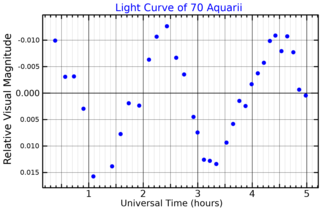
70 Aquarii is a variable star located 425 light years away from the Sun in the equatorial constellation of Aquarius. It has the variable star designation FM Aquarii; 70 Aquarii is the Flamsteed designation. It is near the lower limit of visibility to the naked eye, appearing as a dim, yellow-white hued star with a baseline apparent visual magnitude of 6.19. This star is moving closer to the Earth with a heliocentric radial velocity of –5.8 km/s.
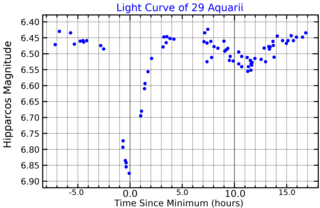
29 Aquarii is a binary star system located around 590 light years away from the Sun in the equatorial constellation of Aquarius. 29 Aquarii is the Flamsteed designation; the system also bears the variable star designation DX Aquarii. It is a challenge to view with the naked eye, appearing as a dim star with a combined apparent visual magnitude of 6.39. The system is moving further from the Earth with a heliocentric radial velocity of about +15 km/s.
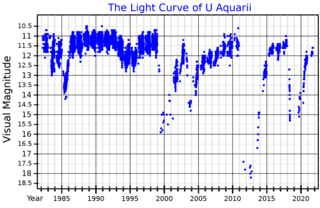
U Aquarii, abbreviated U Aqr, is a variable star in the equatorial constellation of Aquarius. It is invisible to the naked eye, having an apparent visual magnitude that ranges from 10.6 down to as low as 15.9. Based on parallax measurements, the distance to this star is approximately 38 kly (12 kpc). In 1990, W. A. Lawson and associates provided a distance estimate of 43 kly (13.2 kpc) based on the assumption of a bolometric magnitude of −5. It appears to lie several kiloparsecs below the galactic plane, and thus may belong to an old stellar population.

LP Aquarii is a pulsating variable star in the constellation of Aquarius that varies between magnitudes 6.30 and 6.64. The position of the star near the ecliptic means it is subject to lunar occultations.

14 Aquarii is red giant star. 14 Aquarii is the Flamsteed designation; it also bears the variable star designation IW Aquarii. It is a semiregular variable with an amplitude of a tenth of a magnitude, and shows variations on a timescale of just one day.

HU Aquarii is an eclipsing binary system approximately 620 light-years away from the Sun, forming a cataclysmic variable of AM Herculis-type. The two stars orbit each other every 2.08 hours and the ultra-short binary system includes an eclipsing white dwarf and red dwarf.

QZ Puppis is a class B2.5V star in the constellation Puppis. Its apparent magnitude is 4.5 and it is approximately 650 light years away based on parallax.

HD 65750, also known as V341 Carinae is a bright red giant star in the constellation Carina. It is surrounded by a prominent reflection nebula, known as IC 2220, nicknamed the Toby Jug Nebula.

W Aquilae is a variable star in the constellation of Aquila. It is a type of evolved star known as an S-type star. Due to its relatively close distance of 1,200 light-years and equatorial location, it is easy to observe and heavily studied.
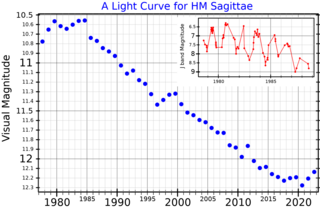
HM Sagittae is a dusty-type symbiotic nova in the northern constellation of Sagitta. It was discovered by O. D. Dokuchaeva and colleagues in 1975 when it increased in brightness by six magnitudes. The object displays an emission line spectrum similar to a planetary nebula and was detected in the radio band in 1977. Unlike a classical nova, the optical brightness of this system did not rapidly decrease with time, although it showed some variation. It displays activity in every band of the electromagnetic spectrum from X-ray to radio.
